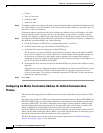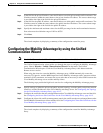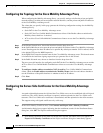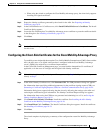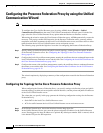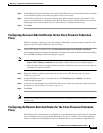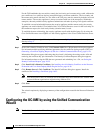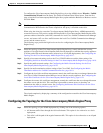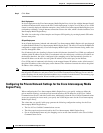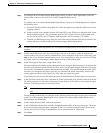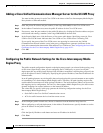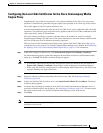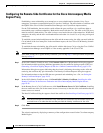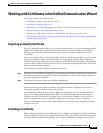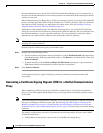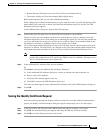
16-18
Cisco ASA Series Firewall ASDM Configuration Guide
Chapter 16 Using the Cisco Unified Communication Wizard
Configuring the UC-IME by using the Unified Communication Wizard
Step 2 Click Next.
Basic Deployment
In a basic deployment, the Cisco Intercompany Media Engine Proxy sits in-line with the Internet firewall
such that all Internet traffic traverses the ASA. In this deployment, a single Cisco UCM or a Cisco UCM
cluster is centrally deployed within the enterprise, along with a Cisco Intercompany Media Engine server
(and perhaps a backup). A single Internet connection traverses the ASA, which is enabled with the Cisco
Intercompany Media Engine Proxy.
The ASA sits on the edge of the enterprise and inspects SIP signaling by creating dynamic SIP trunks
between enterprises.
Off-path Deployment
In an off path deployment, inbound and outbound Cisco Intercompany Media Engine calls pass through
an ASA enabled with the Cisco Intercompany Media Engine Proxy. The ASA is located in the DMZ and
configured to support primarily Cisco Intercompany Media Engine. Normal Internet facing traffic does
not flow through this ASA.
For all inbound calls, the signaling is directed to the ASA because destined Cisco UCMs are configured
with the global IP address on the ASA. For outbound calls, the called party could be any IP address on
the Internet; therefore, the ASA is configured with a mapping service that dynamically provides an
internal IP address on the ASA for each global IP address of the called party on the Internet.
Cisco UCM sends all outbound calls directly to the mapped internal IP address on the ASA instead of
the global IP address of the called party on the Internet. The ASA then forwards the calls to the global
IP address of the called party.
Note When you configure the Cisco Intercompany Media Engine for an off-path deployment, you must ensure
that the public IP addresses and ports of the Cisco Unified Communications Manager servers and the
public IP address for the media termination address are accessible from the Internet. The summary page
of the Unified Communication Wizard reminds you of the requirements.
Configuring the Private Network Settings for the Cisco Intercompany Media
Engine Proxy
When configuring the Cisco Intercompany Media Engine Proxy, you specify settings to define the
private network topology, such the private network interface, the IP addresses of the Cisco Unified
Communications servers, and ticket verification. Additionally, when the Cisco Unified Communications
servers are operating in secure mode, you specify the X.509 subject name for the Cisco Intercompany
Media Engine Proxy,
The values that you specify in this page generate the following configuration settings for the Cisco
Intercompany Media Engine Proxy:
• The list of Cisco Unified Communications servers
• The ticket epoch and password used by the Cisco Intercompany Media Engine Proxy
• For an off-path deployment only, the mapping service on the same interface as the Cisco Unified
Communications server



